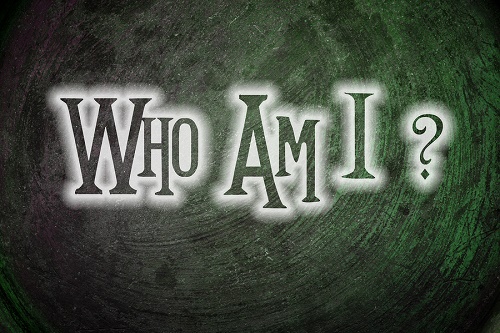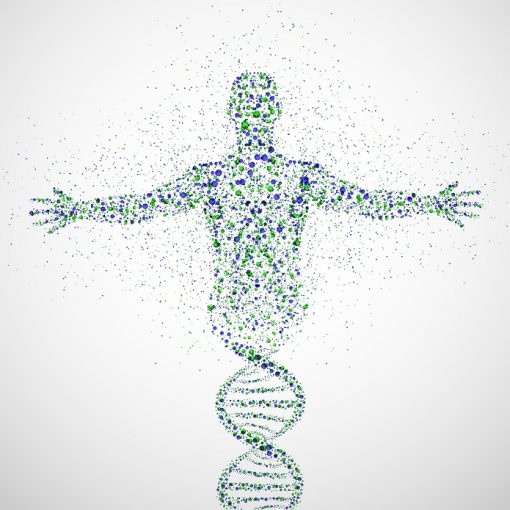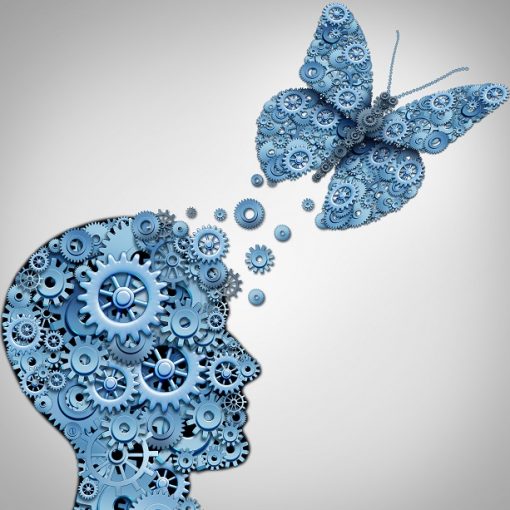
Who in the world am I? Ah, that’s the great puzzle!
Alice, in Lewis Carroll’s Alice’s Adventures in Wonderland.
Human beings can speak, and when a person refers to himself, he uses the first personal pronoun ‘I.’ But the faculty of human thought is extremely complex, and the “I” of the average man/woman is much more than just a label for referring to himself/herself. It is a complex conglomerate of several things, often little understood by the person himself. In Indian spiritual literature, the complex mechanism of the I (Sanskrit: aham ) has been referred to as the “ego” ( ahamkaara ), and it is said to be lost upon spiritual Awakening (Enlightenment or Liberation).
He who is without egoism ( nir-ahamkaara ), who has lost the sense of ‘me’ and ‘mine’ ( nir-mama ), he attains to peace. This is the Brahmi state (state of realisation of oneness with Brahman) . having realised which, one attains Brahma-nirvana (Liberation). Bhagavad Gita, II:71-2, also see XVIII: 53 9,10
But this is not easy to understand. How can a person function without the “I”? How will he see himself, or think of himself? How will he act effectively in this complex, intensely competitive world? Will he, indeed, be able to function in ordinary everyday activities and satisfy the demands of professional life, or will he perforce have to retire from it to the seclusion of the mountains, forest or a monastery? In other words, if spiritual Awakening is tantamount to loss of the ‘I,’ how is this compatible with daily life?
Furthermore, although the philosopher-sage J. Krishnamurti (for example) often referred to himself in the third person (as “the speaker”), this is not universally true and an acknowledged sage like Ramana Maharshi was heard using the personal pronoun as easily as the average person. Was this simply a matter of convenience?
To solve this mystery, we will first have to understand what exactly constitutes the ‘I,’ what specifically is lost upon spiritual Awakening (and why), and what are the practical and psychological implications of such loss. Such a study will also give us an insight into the psychology of spiritual Awakening and Liberation.
The ‘I’ is of course first of all, very simply, a label useful to refer to that particular living unit. Let us call the I-used-as-a-label the I-L (I the label). This `I’ is used both by the Liberated sage and the average person.
But what exactly is it that the label I refers to? When a person says “I,” he certainly means something more than just his body, or even his body-mind. The label does refer to an existing (though conceptual or notional), executive or working/decision-making unit, which we can call I-U (I the unit). Every animal is an autonomous unit that behaves and reacts in a certain way at a given point of time because of certain inherent reasons combined with certain external events. We call this “making decisions.” Human beings, neurologically developed to the point of self-awareness, know this fact and refer to their own autonomous decision-making unit as ‘I’. Thus there is an executive ‘I’ that functions in day-to-day life and acts and reacts in certain ways. This may be better understood if a human being is thought of as a corporation of several cells, just as a company is a composite of several individuals. I-L is the name of the corporation, and I-U the entity of the corporation itself. This entity, like a company or corporation, has a legal, economic and factual existence, but ultimately it is still a concept. In other words, it is a notional entity. In Buddhist literature, the monk Nagasena is said to have explained this to his king Milinda by using the example of the king’s chariot. The chariot is a contraption consisting of wheels, horse and other items put together in a certain way. But dismantle that and where is the chariot? Thus, although the chariot (when so assembled) has a definite physical reality and existence, when dismantled it becomes clear that its “chariot-ness” is nevertheless a concept. So is it with the executive I (the I-U). It is this I that the sage refers to when he says, for example, “I did this.” This is a mere statement of fact, not relevant to either claiming of personal credit or admission of personal guilt.
The I-U is thus an arbitrary (conventional), working classification, immensely useful in daily life. But because humans, like most other animals, are physically disparate, we tend to forget that this is so, and we consider people to be separate ‘skin-encapsulated’ entities. This distinction is less obvious say in a case of severely conjoint (Siamese) twins where it is difficult to say exactly where ‘one’ of them ends and the ‘other’ begins, or even, say in the much more common instance of a pregnant woman. Is the foetus part of her ‘self,’ or is it an ‘other’?
Because we are thinking, self-aware animals, we also have a mental image of “ourselves.” This too forms a part of the conglomerate I. This is a composite of past memories regarding ourselves (past experiences), what others have said about us, and so on. This is the I-M. In effect, this, as psychologist Ken Wilber has put it, is simply a “bag of edited memories.”
It is the I-M that is spiritually significant, because it is the cause of self-centred thinking and mental conditioning, self-centred expectations, and consequently of much avoidable suffering. In spiritual terms, it is this that is referred to as the ‘ego,’ which is different from the use of that term in Freudian psychology. In Indian philosophy it is called ahamkaara. This is also the apparent doer of ‘our’ actions. The actual doer is the I-U (to put it more accurately, the I-U is, by convention, considered the doer of the action so that we do not constantly have to talk in the passive voice). The I-M is only the apparent, and not the real doer. It is actually no more than a mental construct or image, without substance, and has no real (physical or `spirit’-ual) existence. Thus the authorship of deeds is laid at the door of an entity which does not really exist, except as a mirage or a memory. This false sense of doership is called “kartruttva bhaava” in Indian philosophy. This error of understanding is at the root of all sense of pride, guilt and moral blame. It is this `I’ which the ordinary man refers to when he says “I did this.” It is a statement pregnant with pride or guilt, a statement in which one of these two is naturally immanent, inherent. Contrast this with the sage’s meaning when he makes a similar statement (earlier paragraph).
The Buddha said:
“Deeds are done, and so accordingly do the resulting consequences come to be, yet the doer has no existence. Like a clear mirror, according to what comes before it, reflecting forms, each different, so is the nature of action.”
(Garland Sutra 10 )
The I-M which is ordinarily considered the doer, has no real existence. And the I-U is merely the notional doer, a figure of speech used for convenience of language. Deeds occur according to the fixed laws of Nature (the clear mirror, reflecting faithfully) and the inherent nature of the organism interacting with the environment (forms reflected).
The difference between the I-U and I-M may not be easily apparent at first glance. So let us elaborate a little. The I-U is a notional centre, location or locus where decision-making takes place, rather than an entity or a ‘person’ who “decides.” It is a “where” rather than a “who.” Psychologist B.F.Skinner said that we are “a place in which certain genetic and environmental causes come together to have a common effect” and that although we take credit for our ideas as if we created them out of an act of will, we are really just a “place where ideas happen.” Ideas, he said, happen inside us much as an egg happens inside a hen 7 .
At the end point of Final Liberation (see later), the “who” that appeared to make decisions (the I-M, a self-image) has disappeared, yet effective decision making continues to occur, because the “where” that decisions took place (the I-U) is unaffected. In fact, the process of decision-making happens more efficiently, untrammelled by unnecessary fears and anxiety about personal credit or risk (which was related to the I-M). At the same time, since there is no “one”, no “who” to claim authorship for the action, there is none to take delivery of pride or blame either.
Finally, there is the ultimate “realification” of the I. The final imbuing with life, in which a belief is superadded that this I is a separate entity by itself over and apart from all that we have just mentioned – something that will survive the death of the body and reincarnate in another body (or go on to enjoy an afterlife). This is I as the soul or spirit or self – the I-S – typified by the question “What will happen to ME after I die?” (If the me or I is dead, how can anything happen to it after that?). In Indian spiritual literature this is referred to as the jivatman (pronounced “jeevaatmaan”), the (apparent) individual ‘soul’ (see note at end of article). Even if the person does not believe in the soul or afterlife, there is still the conscious or unconscious belief in (and identification with) a `me’ which exists during life, and which passes through the different stages of life – from birth to youth to old age to death. There is the belief in the continuity of a ‘me’ which is seen as going through time in a linear fashion.
The difference between the I-M and I-S? The I-S comprises the conscious or unconscious belief in the actual existence of the self. In other words, it comprises the identity of (and identification with) the presumed self. The I-M comprises its body or description – it describes the self (for example, as a businessman or engineer or doctor, with a particular life history, and so on).
Thus the I-S is the I-M (or self-image) further crystallised in thought and belief to the extent that it is mistakenly considered to be an independent self-entity, a ‘me,’ residing in the body, which passes through the different stages of life, and that, after the death and dissolution of the body, perhaps even survives into an after-life.
The proper understanding of the entire psychology of the I ultimately leads to the actual seeing of the I-S as false, as just a belief. The actual perception of (or insight into) this fact is Enlightenment. It is important to understand that when the actual recognition occurs, it is intuitive rather than intellectual, a matter of instant, intuitive perception and recognition rather than mentation or cerebration, a matter of insight rather than intelligence. As this is a shift in perspective, it happens suddenly (a paradigm shift). It may well happen in a series of small sudden shifts, but the classical description in spiritual literature is that of one massive shift. The shift is attended by a great sensation of relief, partly because of the sudden loss of a mental load, the spiritual baggage, partly also because of the sudden freedom from further spiritual self-expectations. This marked sense of relief has been likened to a man taking off a heavy burden which he has been carrying on his head, or of a man coming out of the scorching sun into the cool shade. Because of the nature of Enlightenment, further spiritual maturation (it is no longer seen as spiritual “progress”) is seen to occur spontaneously rather than from directed efforts towards that end.
As a natural result of seeing the I-S as false, the spontaneous dismantling of the I-M is initiated (primarily because of lack of reinforcement of conditioning). This is the process of Liberation. At the ultimate end-point of Liberation (‘Final’ Liberation), the I-S has already long been seen as false, and now the I-M has practically vanished as well (except the spiritually insignificant bare minimum required for efficient daily living – see later). All that is left is the I-U (the notional executive unit comprising the body and mind) and of course the I-L, the label. The I-U is now able to work completely untrammelled by the burden of self-centred memory and expectation hitherto imposed by the I-M and the spiritual baggage and imposition resulting from the belief in the I-S. It is truly Liberated. It is also full of spontaneous love because it was the I-M which created the duality of the me and the other. Now, although the me and the other remain as executive units (I-U and O-U), they are merely technical, functional, day-to-day classifications for convenience. The “I-ness” of the I and the “otherness” of the you is lost and there is therefore no basis for alienation, enmity, blame, envy.
What exactly do we mean by the “bare minimum” of I-M required? A certain bare minimum of I-M will be necessary for any person for efficient daily functioning in his chosen vocation, whatever that may be. But the pertinent difference is this: Whereas the average man feels exalted by perceiving “himself” (I-M) as a “success” and crushed by perceiving himself as a “failure,” the Liberated person may be pleased and disappointed respectively by the `successes’ and `failures’ in the particular individual tasks or enterprises that he undertakes, but he does not perceive or label himself [the I-M] as “a success” or “a failure.” As a result, whatever the Liberated one may think himself to be or however he may see himself (insofar as it is necessary for his efficient daily functioning), this (his ‘bare necessity’ I-M) does not affect his happiness.
Another aspect of liberated living that is at least as important as valuation, is continuity through time. What the I-U adds to I-L is the notion of agency; and what the I-M and even more so, the I-S add to both is the notion of continuity. The Liberated person is liberated from the sense of continuity in time, meaning that he has understood, nay, seen , that this continuity is an illusion, much like the apparent continuity of the various stills of a motion picture when shown in quick succession. Bereft of this life-giving continuity in time, his I-S dies a quiet death, and the I-M is starved to exhaustion – practically vanished, virtually absent or spiritually insignificant. In the case of the average person, it is his warped sense of continuity that has him clinging to past or future (as “his” past or future, in relation to his I-S and I-M). By not accepting the past as past or the future as future, he does not allow his “whole” self to step into his own present. The Liberated one, on the other hand, does not cling to the experiences, but moves on . This is what is called living in the “HERE and NOW” and “dying” to the past, to every moment as it passes, as philosopher J.Krishnamurti repeatedly emphasised.
So enlightenment is not incompatible with a notion of `myself’ (`bare minimum’ I-M) as (apparently) continuous with time, but with (a) whether this valuation is taken so seriously that it affects one’s happiness, and (b) whether there is clinging to past or future in a way that rips away attention from the present 9,13
There is in reality no individual in the sense of a spiritual “who” that will reincarnate and is morally answerable for ‘his’ or ‘her’ deeds, but there is a definite biological “where” in which (or where) decisions are made (volitional centre). The “where” is more of a scientific locus, as opposed to the “who” which is a religious or ontological concept or assumption. (Thus volition, or an appearance of it, may be said to exist at an everyday, conventional level in that sense. It is not really volition itself that is being denied, but rather the “who” that is supposed to “have” it).
Ironically then, Enlightenment is the very perception (seeing) of the absence of a real self or I (as is generally thought to exist) – and thus inevitably, of the absence of any I who could “be Enlightened.” Ironically then, Liberation is being Liberated from the tyranny of the very I who seeks Liberation! In other words, it does not happen TO an I, it happens FROM an I!
And to whom does Liberation happen? Whom, indeed! Ironically then, when Liberation happens, the “whom” has disappeared!
The realisation of this truth has been likened to the peeling of an onion, where successive layers of the I are seen to be false. The I-S is the most false. It is just a thought or belief in the mind. The I-M is a concept which has an existence but only as a mental image, a “bag of edited memories.” The I-U is a notional entity that has a definite and required existence as a working concept. The I-L is just a word, a label.
In the end, like the peeled onion, there is nothing – shunya . And yet this nothing is everything, for it feels a love and compassion which encompasses the whole of creation. Though it functions most efficiently in the proximate, everyday world, yet it sees no separation between itself and the rest of the world. For, how can nothing be different from nothing?
I live, yet not I, but Christ – the eternal Logos – liveth in me.
St.Paul
What exactly is this shunya, nothing or ‘not I’ that is left after Liberation? Let us try to understand this further. Whatever we think we are is ultimately a thought, and therefore the content of (`our’) consciousness (however refined or subtle). But surely, if we go on eliminating thus, we cannot but reach the inevitable conclusion that what we really are can only be consciousness itself – in its human mode or manifestation, recognisable as aware-NESS. It cannot know itself, for whatever it knows is its content. In other words, whatever it is aware of is its content, so it cannot be aware of itself. Regarding itself, it can only be aware, period. Consciousness, though not “felt” in that sense of the term, is however identifiable (after Liberation) as the irreducible sense of anonymous presence (awareness of presence or pure presence) upon which all other phenomena (or sensations) are displayed (the content), like the screen upon which the pictures are projected.
Thus the experience of nirvana or Liberation is not something esoteric, otherworldly, magical or superhuman. It is simply the awareness that forms the background and basis of all our sensations. It is the elemental sense or sensation present and `felt’ as an undertone to all other sensations at all times by the enlightened. It is present in the unenlightened too, but goes completely unnoticed by them in the hurly-burly and din of daily living. The difference in the enlightened is not in the manner of daily living, but in the inner silence that enables him to be keenly alive to this primal awareness that is the core and basis of his very being. This, the ‘not I,’ or the I-that-is-left, is then the same as what has been called Reality, Truth, or God:
ana’l -Haqq “I am the Truth.”
Mansur Al-Hallaj, 10th century Sufi mystic.
What does it feel like? Although not an experience in the ordinary sense, the ‘flavour’ of this basic awareness or pure presence is described as a positive, benign, causeless, contentment. It is the ananda (contentment, peace) of Indian spiritual literature. It is the ananda (contentment of being, joie de vivre) inseparable from the sat-cit (true, core, basic presence or being), thus giving rise to the familiar Hindu description of consciousness as sat-cit-ananda.
About Enlightenment
It was promised earlier in this article that such a study of the ‘I’ would also give us an insight into the psychology of spiritual Awakening and Liberation. To reformulate and recapitulate, we can now easily understand the following the points about Enlightenment in brief:
The sudden insight into the real nature of the I results in a complete change of perspective on life. The hitherto strong ego-centric perspective of the average person changes to a softer, broader perspective which allows many more points of view and possibilities.
Such sudden insight into the nature of the I with its accompanying sudden change of perspective is termed Enlightenment in the Eastern spiritual tradition.
Enlightenment and its changed perspective lead to a process of de-conditioning from the effects of the earlier egocentric conditioning which had built up throughout life. This is the process of what has been called ‘Liberation.’
As the layers of the I soften and dissolve, the obstructions decrease to the ‘feeling’ of the primal consciousness, the sentience ( prajna ) which animates the body and is our very being. The inherent ‘taste’ of this being-consciousness can be described as ananda, or causeless contentment or peace, the “peace that passeth understanding.”
Paradoxically enough, daily life goes on even more efficiently than before as the executive-I functions untrammelled by the nagging botheration caused by the unreasonable anxieties, phobias, biases, and fears linked to the soul-I (I-S) and the ego-I (I-M).
What about the ordinary pleasures of everyday life? Are they lost? Or are they engulfed by an overwhelming bliss that is continuously felt after Liberation?
Neither. The daily pleasures are felt and enjoyed even more keenly, because they are enjoyed fully, wholly and whole-heartedly. But there is no clinging to them as in the average person. And the reason why there is no clinging is that there is constantly the intuitive understanding, insight or sensing that it is the consciousness upon which they are projected, and without which they would not be felt, which is abiding and important. It is intuitively known that the passing pleasures come and go, but the primal consciousness and its inherent taste, ananda, abides and is the basic necessary condition for them to be felt and experienced at all, anywhere, anytime.
At the theoretical final point of Liberation, ananda (or the causeless contentment of being) remains fully uncovered. This is felt (by `induction’) even by other people in close physical proximity to the Liberated sage – the “river of peace” effect.
There is something in this man which holds my attention as steel filings are held by a magnet. I cannot turn my gaze away from him…a steady river of quietness seems to be flowing near me… a great peace is penetrating the inner reaches of my being… “Does this man… emanate the perfume of spiritual peace as the flower emanates fragrance from its petals?”
Paul Brunton, about Ramana Maharshi 2
Typical `average’ person
- Thought: Restlessness (Nihilism to absolutism)
- Action: Confused (Over-control to impulsiveness)
- Emotion: Temperamental (Inhibition to emotionalism)
- Attitude/perspective: Self-centred
- Moods: Fluctuating, totally dependent on circumstances (external or internal)
Advanced seeker
- Thought: Emptiness (effortful or contrived)
- Action: Surrender (volitional)
- Emotion: Detachment or non-clinging (contrived, rationalised)
- Attitude/perspective: Un-self-centred (learnt, trained or habituated)
- Moods: Steadily composed, not fluctuating, not dependent on circumstances (external or internal). Result of training.
Final Liberation
- Thought: Mindfulness (natural, effortless, spontaneous)
- Action: Spontaneous (easy, appropriate, flowing)
- Emotion: Compassion (karuna) and loving kindness towards all (Buddhism: metta), both of which are natural, spontaneous – a result of dissolving of the me/other distinction.
- Attitude/perspective: Completely un-self-centred. Natural, not result of training.
- Moods: Easy, possibly fluctuating, dependent on circumstances (external or internal), but only on the ‘surface.’ Deep mood firmly anchored in the “inner peace” (ananda), which is the necessary sub-stratum of all sensations and hence always present.
Notes
(1) Self-enquiry; a spiritual method, process or exercise popularised by the renowned sage Ramana Maharshi (1879-1950) from southeast India (`Who am I? – Nan Yar? in the south Indian language, Tamil). It is mentioned in ancient Hindu spiritual literature (the Sri Vasistha Sangraha II, 44-6), and is also known in Buddhist literature (Ch’an: i-ching or Great Enquiry) – “inquiring after the inquirer himself” (Ku-yin). In Western philosophy too, the exhortation to “Know thyself” has similar implications. And a Sufi saying goes ” Whoso knoweth himself, knoweth his Lord” 12 (p.81).
Self-enquiry is not a method of sitting meditation. It refers rather to an inner attitude of constant introspective investigation or `looking inward’ to see into one’s own mental processes, and understand the psychological composition of the `me’ or `self’ within. Whereas all other methods assume a `doer’ of those respective methods, Self-enquiry strikes at the very root of doership by questioning `who’ is the `doer’ of any method (or the `thinker’ of any thoughts)! The object of Self-enquiry is thus not to get an answer (say like `I am pure awareness’) but rather to feel the absence of any superimposed entity (`self’) whatsoever, this very absence being the ‘finding’ of ‘pure presence’ or ‘pure awareness.’ (Zen: “This not finding is itself the finding”). Self-enquiry is thus the method to end all methods. For a detailed discussion, see Osborne, Arthur, The Teachings of Bhagavan Sri Ramana Maharshi in His Own Words pp.130-167.
The concept of consciousness and its content can also be used to explain the basis of self-enquiry. Self-inquiry can be seen as focussing more on consciousness (Who am I, or Who is doing the thinking) rather than its content (What am I, or what am I thinking), on the `screen’ rather than on the `pictures’ projected on it.
(2) In Indian spiritual literature the I-S is referred to as the jivatman, the (apparent) individual soul. The jivatman is said to be apparent not because consciousness does not exist. It is perfectly obvious that it does (or else who or what is reading and understanding these words right now?). It is its existence as a separate embodied piece or unit of consciousness that is denied. In other words, the consciousness is real, it is the separateness that is unreal.
Since the [jivatman or individual soul = Consciousness + separation], if separation is unreal or only apparent (a mirage), then what is left in the equation is [ jivatman = Consciousness ]. Thus (individual) consciousness freed of, or devoid of, the sense of separation is none other than (Universal) Consciousness. It is therefore said in Hindu Vedanta that the jivatman is actually no different than the paramatman (Universal Consciousness or “God”).
Nitin Trasi is the author of the book ‘The Science of Enlightenment’, Pub: D.K. Printworld (P) Ltd., New Delhi, 1999. He is also the author of several published articles on the psychology of spirituality and spiritual awakening. A Fellow of the World Academy of Art & Science, he is a medical practitioner by profession.
Email: [email protected]
Homepage: http://personal.vsnl.com/ntrasi
References
1. The Teachings of Bhagavan Sri Ramana Maharshi In His Own Words edited by Arthur Osborne, 5th Ed., Ramanasramam
2. A Search in Secret India, Paul Brunton, B.I.Pub.,1970, reprint 1994.
3. Srimad BhagavadGita-Rahasya by Bal Gangadhar Tilak, English Translation by Bhalchandra Sitaram Sukthankar, 6th Ed., 1986, Geeta Printers, Pune.
4. The BhagavadGita, Gita Press, Gorakhpur, India. 5. The Last Talks, J.Krishnamurti, K.F.I., Pub.1989, Reprint 1992.
6. The Wholeness of Life, J.Krishnamurti, K.F.I., 1978.
7. Introduction to Psychology, Morgan, King, Weisz and Schopler, Pub.Tata McGraw-Hill, 7th Ed, p.595 *(B.F.Skinner).
8. The Science of Enlightenment, Nitin Trasi, D.K.Printworld (P) Ltd., New Delhi, 1999.
9. The Inner Rhythm of Enlightened Activism, Gary Schouborg, website: www.somawake.com Email: [email protected]
10. The Bhagwad Geeta with the commentary of Sri Sankaracharya, English translation by Alladi Mahadeva Sastry, Pub. Samata Books, Madras, 1977 Ed., (1992 Reprint).
11. Srimad Bhagavad Gita, Swami Swarupananda, Advaita Ashrama, 1996, Calcutta
12. Sufism, William Stoddart, Suhail Academy, Lahore, Pakistan, 1981.
13. Enlightenment in Action: Somatic Feeling and Time, Gary Schouborg, website: www.somawake.com, Email: [email protected]
byTrasi Nitin




